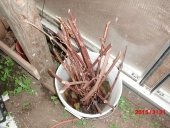posted 7 years ago
I looked up apples, only in the Stark Bros catalog. because I seemed to remember seeing credits, this is what I found:
Ginger Gold is a registered trade name of Adams County Nursery, Inc. on page 6 of the 2018 catalog.
Crimson Crisp is being offered under license from Adams County Nursery, Inc. on page 6 of the 2018 catalog.
Jonagold A licensed variety of Cornell University, on page 6 of the 2018 catalog.
Freedom A licensed variety of Cornell University, on page 9 of the 2018 catalog.
Cortland A licensed variety of Cornell University, on page 9 of the 2018 catalog.
Liberty A licensed variety of Cornell University, on page 10 of the 2018 catalog.
September Wonder Fuji September Wonder is a trademark of C&O Nursery, Inc. on page 10 of the 2018 catalog.
"Co-Op 31 Winecrisp" May be covered by USPP #20,437 or other patents. on page 10 of the 2018 catalog.
Stark Bros Exclusive Snappymac USPPAF 'Gunnison' cultivar on page 11 of the 2018 catalog.
Empire A licensed variety of Cornell University, on page 11 of the 2018 catalog.
Kindercrisp May be covered by USPP #25,453 or other patents on page 11 of the 2018 catalog.
Candycrisp May be covered by USPP #17,284 or other patents. "Greiner 1198' cultivar on page 11 of the 2018 catalog.
So, I see three different references above. Under license, a registered trade name, and covered by ## patents. In some cases the particular name is trademarked, in some cases the cultivar is patented. Where it says under license from XX you'd have to contact the organization referenced. As you can see there doesn't appear to be an extra charge made to the buyer of the seedling. Apparently Stark is willing to pay a small fee to sell the variety or cultivar because I assume they think that item is of enough merit to make the charge worthwhile. It's my opinion that in most cases the charge is about $1, more or less. However I once found a new apple variety that the growers of Rome apples in Ohio had developed, I think it was <blank>crisp. I tried googling it and can't find the story. The reason I bring it up is that they want a small fee per year into the future. To me, it's not worth the bother of mailing some guy the 20¢ a year for the one tree I'd be interested in. And then they are only selling it in multiples.
I only looked up apples in the Stark catalog, no other items. And if you take what I say as gospel without looking up what I say then you're responsible for your mistake.
Another thing I googled "Jonagold apple history" and I got this across the top of my search results: Jonagold apples originated in 1953 at the New York State Agricultural Experiment Station in Geneva, New York. My reason for bringing this up is that 1953 seems to me to be more than 20 years.
I would say that you need to make a decision as to what items to sell. One of the things you need to analyze is what do your potential customers want. If your apple customers want the apples above, for instance, then you might just have to make up your mind to pay the royalties, or fees to the appropriate place so that you can be comfortable selling what you need to. After you go to the trouble of grafting and raising your rootstocks and or seedlings. It might make life easier doing the right thing. It can be very expensive paying attorneys and expert witnesses to defend a lawsuit. And then you'd lose your good name. Remember this: it's your customer who will ultimately pay the royalty. But I have to admit that I don't know the way paying these fees goes. Do you pay them when you do the graft, or only after you've made the sales. This is important if you have to pay a royalty on unsold or dead trees.
I hope I'm not scaring you off your dream. Good luck.
edited: while I wrote this I got logged out, when I recovered it the first sentence got truncated out, and possibly more??




 3
3





 8
8




 4
4












 6
6




 4
4





 7
7




 4
4





 2
2




 3
3









